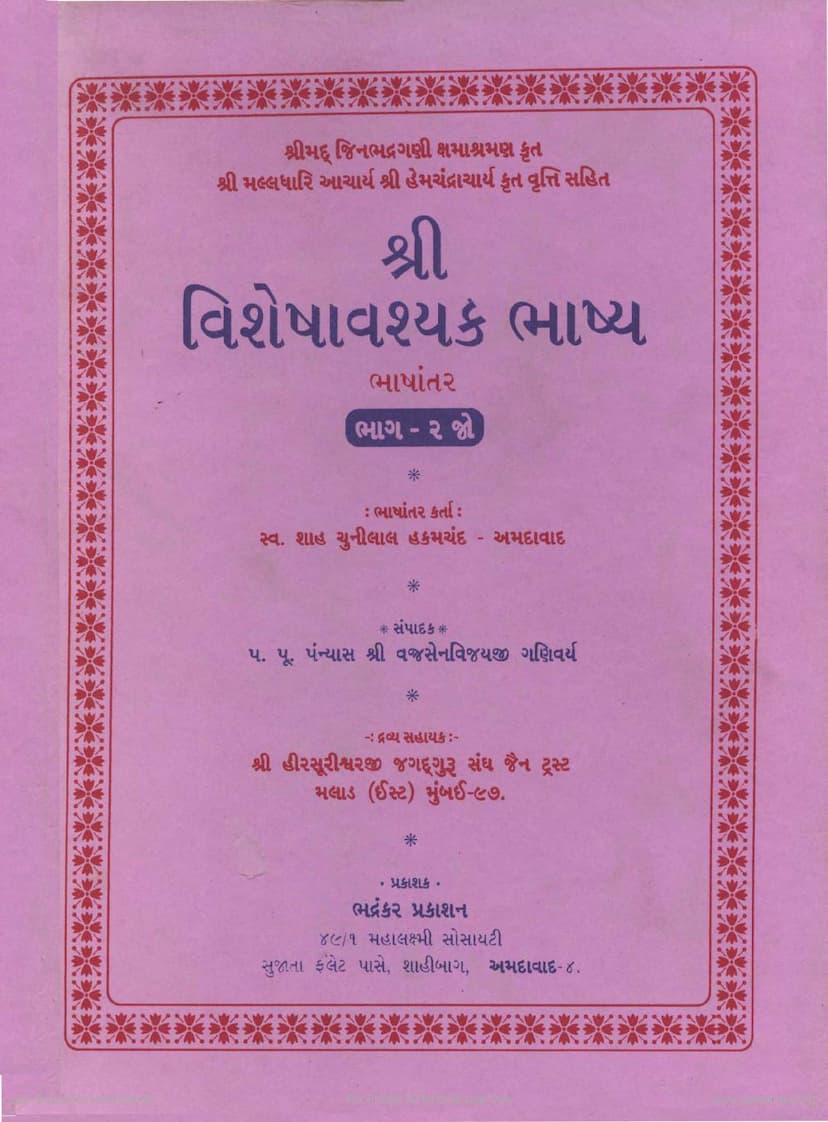Visheshavashyaka Bhasya Part 2
Added to library: September 2, 2025

Summary
Based on the provided Gujarati text and the catalog link, here's a comprehensive summary in English of Visheshavashyaka Bhasya Part 2 by Acharya Hemchandracharya, with commentary by Vajrasenvijayji:
Book Title: Visheshavashyaka Bhasya Part 2 (Gujarati Translation) Original Author: Acharya Jinbhadra Gani Kshama Sraman Commentary Author: Acharya Nemichandra Gani (Shataka) and Acharya Hemchandracharya (Vritti) Translator: Late Chunilal Hakmchand Shah Editor: P.P. Nyas Shri Vajrasenvijayji Ganivarya Publisher: Bhadrankar Prakashan Content Covered: This volume, specifically, covers stanzas from 1549 to 3603 of the Visheshavashyaka Bhasya.
Overall Purpose:
The Visheshavashyaka Bhasya, originally composed by Acharya Jinbhadra Gani Kshama Shraman and later commented upon by Acharya Hemchandracharya, is a foundational text in Svetambara Jainism. It elaborates on the essential six actions (Sadvashyaka) prescribed for ascetics, particularly focusing on the principles of Samayika. Part 2 of this translation delves deeply into complex philosophical and logical arguments, aiming to provide a clear understanding of Jain principles in Gujarati for spiritual seekers.
Key Themes and Content:
This volume is characterized by its intricate and detailed exploration of various Jain philosophical concepts, often through extensive dialectical debates (vada). The summary of the table of contents highlights the following major areas covered in Part 2:
-
Ganadharavada (Debates of the Ganadharas): A significant portion of the text is dedicated to the detailed discussions held by the eleven Ganadharas (principal disciples of Mahavir Swami) with their master. These debates address fundamental questions of existence, the nature of the soul, causality, and the validity of knowledge (pramanas). Each Ganadhara raises specific doubts, often stemming from their prior knowledge of Vedic or other philosophical systems, which are then resolved by Lord Mahavir's profound and logical explanations.
- Gautam Ganadhar: Debates the existence of the soul, its perceptibility, and the role of inference and scripture.
- Agnibhuti Ganadhar: Discusses the nature of Karma, its connection to Vedic verses, and the concept of rebirth.
- Vayubhuti Ganadhar: Explores the relationship between the soul and the body, and the benefits of differentiating them.
- Vyakt Ganadhar: Addresses doubts about the existence of elements and the interpretation of contradictory Vedic texts.
- Sudharma Ganadhar: Examines the origin of things and the meaning of Vedic verses.
- Mandik Ganadhar: Discusses bondage (bandha) and liberation (moksha) and refutes alternative viewpoints.
- Mauryagupta Ganadhar: Deals with the existence of divine beings (devas) and refutes negative arguments.
- Akampit Ganadhar: Addresses the nature of hellish beings (narkis) and sensory perception versus direct perception.
- Achalbhrata Ganadhar: Explores the concepts of merit (punya) and demerit (papa), their nature and existence.
- Metarya Ganadhar: Discusses the reality of the afterlife, the interpretation of Vedic verses, and the nature of causality.
- Prabhas Ganadhar: Focuses on the concept of liberation, the eternal nature of the soul and liberation, and the nature of true happiness.
-
Naya-Nirikshana (Analysis of Syadvada and Nayas): The text extensively discusses the various Jain epistemological categories known as 'Nayas' (standpoints or perspectives). It meticulously explains the seven Nayas (Naigama, Sangraha, Vyavahara, Rujusutra, Shabda, Sambhruhta, and Evambhuta) and their application in understanding reality. The text highlights how different Nayas offer partial but ultimately valid viewpoints when considered in relation to the whole truth (Syadvada). This section is crucial for understanding Jain logic and its sophisticated approach to knowledge.
-
Nirvriti and Vyucched (Discourse on Liberation and Causality): The text touches upon the concept of liberation (Moksha) and the processes leading to it. It analyzes the nature of karma, its bondage, and its eventual shedding, a crucial aspect of Jain soteriology.
-
Substance and Soul (Dravya and Jiva): The text often contrasts materialistic interpretations of existence with the Jain understanding of soul (Jiva) as an independent, eternal, and conscious entity, distinct from matter (Dravya). It clarifies the subtle relationship between substance (dravya) and its qualities (guna) and modes (paryaya).
-
Logic and Epistemology: A significant portion of the Bhasya is dedicated to dissecting logical arguments, philosophical viewpoints, and the validity of knowledge sources. It systematically refutes non-Jain perspectives and establishes the Jain framework of Syadvada, Anekanta, and the Seven Nayas.
-
Ethical and Ascetic Principles: Underlying the philosophical discussions are the practical implications for Jain ascetics. The text emphasizes the importance of right faith, right knowledge, and right conduct (Samyakdarshan, Samyakjnan, Samyakcharitra) as the path to liberation.
Key Concepts Elaborated:
- Pramanas (Sources of Knowledge): Detailed discussion on Pratyaksha (direct perception), Anumana (inference), and Agama (scriptural authority) as valid means of knowledge in Jainism.
- Anekanta Vada (Non-absolutism): The text illustrates how different Nayas and standpoints offer partial truths about reality, and how Syadvada reconciles these seemingly contradictory views.
- Nayas: The core of the philosophical discussions revolves around the seven Nayas, explaining their meaning, application, and how they help resolve epistemological puzzles.
- Karma Theory: The intricate workings of karma, its causal relationship with actions, and the means of its cessation are explored.
- Soul (Jiva): The eternal, conscious, and multifaceted nature of the soul is explained, differentiating it from physical matter and the non-sentient (Ajiva).
- Liberation (Moksha): The text elucidates the path to liberation, emphasizing the role of right knowledge, conduct, and the shedding of karma.
- Vedic Interpretation: The text engages with and often reinterprets Vedic verses to align them with Jain philosophical tenets, particularly in the debates with Ganadharas who had prior knowledge of these texts.
Significance of Part 2:
Part 2 of the Visheshavashyaka Bhasya translation is particularly noted for its deep dive into complex logical arguments, the detailed analysis of the Nayas, and the extensive refutation of other philosophical schools through dialectical engagement, especially the debates with the early Ganadharas. The editor, Pandit Vajrasenvijayji, and the translator, Chunilal Hakmchand Shah, have made this profound work accessible in Gujarati. The publication is supported by the Shri Hirsurishwar Jagadguru Sangh Jain Trust.
In essence, this volume serves as an intellectual journey into the core philosophical tenets of Jainism, providing a rigorous and systematic exploration of its logic, ethics, and path to spiritual emancipation.